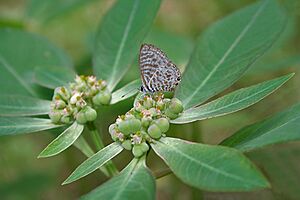Euphorbia heterophylla facts for kids
Quick facts for kids Painted euphorbia |
|
|---|---|
 |
|
| Scientific classification | |
| Genus: |
Euphorbia
|
| Species: |
heterophylla
|
| Synonyms | |
|
|
Euphorbia heterophylla, also known as painted euphorbia or fire on the mountain, is a fascinating plant. It's part of the spurge family, which is famous for its unique flowers and sometimes milky sap. This plant has many common names, including Mexican fireplant, Japanese poinsettia, desert poinsettia, wild poinsettia, paintedleaf, painted spurge, milkweed, and kaliko plant.
Contents
Where It Grows
Euphorbia heterophylla originally comes from warm, tropical, and subtropical parts of America. But now, you can find it all over the world in tropical areas. It has spread very quickly in many places. This is because some common plant-killing chemicals (herbicides) don't work well against it.
People brought this plant to South and Southeast Asia as a pretty plant to grow in gardens. However, it has become a common weed in countries like India and Thailand. It can even take over cotton fields and other farm lands.
What It Looks Like
This plant usually grows to be about 30 to 100 centimeters (about 1 to 3 feet) tall. It has hollow stems that can be simple or have branches. The leaves on the plant can look very different, even on the same plant! The lower leaves grow in an alternating pattern, while the upper leaves grow directly opposite each other. These upper leaves often have a bright white or red color at their base.
Life Cycle and Reproduction
Euphorbia heterophylla can grow very quickly. It might start to flower within 30 days of sprouting from a seed. Then, it takes about 25 to 30 more days for its seeds to become fully ready. Insects help pollinate the plant because they are attracted to the large amounts of sweet nectar it makes.
The plant has special "false flowers" called cyathia. These are yellowish-green and grow in groups at the top of the stem. They don't have petals. The bright red color you might see is actually part of the young leaves around these false flowers.
When the plant is mature, its fruits are small, segmented capsules. These fruits have a cool way of spreading seeds: they explode! This shoots the seeds far away from the parent plant, helping new plants grow in different spots.
Sometimes, when this plant grows wild as a weed, it loses its bright colors. Also, some groups of these plants in South America have become resistant to certain plant-killing chemicals.
Is It Safe?
Most plants in the Euphorbia family have a milky white sap, also called latex. This sap can be irritating. If you are sensitive to latex, touching the sap from Euphorbia heterophylla can cause skin irritation or other strong reactions. It's always best to be careful and avoid touching the sap directly.
As a Weed
Euphorbia heterophylla is known for being a tough weed. In its home country of Brazil, some types of this plant have even developed a way to resist certain plant-killing chemicals (herbicides) like fomesafen and imazethapyr. This makes it harder for farmers to control its spread in their fields.
See also
 In Spanish: Euphorbia heterophylla para niños
In Spanish: Euphorbia heterophylla para niños


